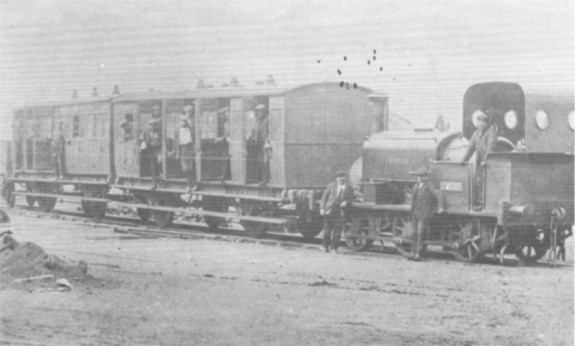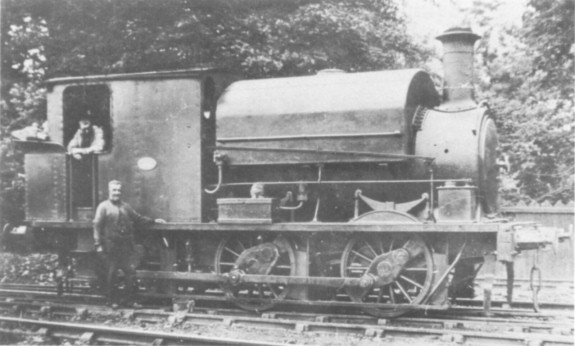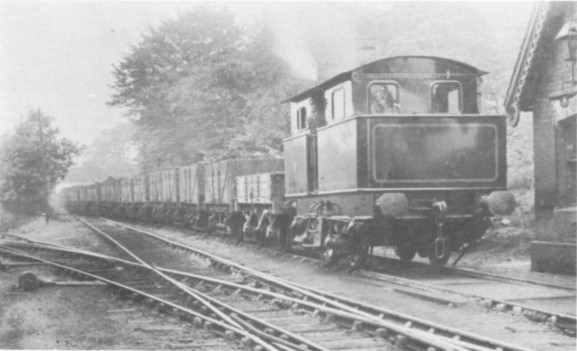
| THE INDUSTRIAL RAILWAY RECORD |
© AUGUST 1973 |
PICTURE PARADE
C. A. APPLETON
Correspondence in RECORD 42, page 231, covered a topic of early Bridgewater Collieries locomotive history and featured an illustration of a vertical boiler locomotive which worked on this system. This was one of a series of copy photographs I made some years ago from originals in the possession of Mr. H. Tweedy, former traffic foreman on the Bridgewater lines. The other photographs are reproduced here and make a rather interesting collection.
The first view shows FRANCIS (Manning Wardle 311 of 1870) on the little known Paddy train. As far as is known this workmen's train, at its 'zenith', ran all the way from Worsley to Mosley Common via Sandhole, Ashton's Field (where reversal took place), and Walkden. Latterly it is thought to have run from Worsley to Ashton's Field only, and its final withdrawal probably coincided with the introduction of tram-car services in the locality. I do not have definite details of the disposal of FRANCIS, but I used to know an old chap who was adamant that it was 'taken away by a Sheffield firm for further use.' The body of a coach, probably one from the Paddy, was in use at Sandhole colliery in relatively recent times, and maybe until the colliery closed. A more modern inside cylinder locomotive, GRAND DUCHESS was also a product of Manning Wardle (484 of 1874) and had an exceptionally large cab to accommodate the whole of the firebox. The name GRAND DUCHESS was painted on the saddle tank above the hand rail but is barely visible in the photograph, which was taken at Sanderson's Sidings. (These sidings were one of the system's several outlets and were adjacent the LNWR Manchester - Wigan line near Worsley station). The Atkinson Walker vertical boiler locomotive shown 'posed' at Sanderson's Sidings was on trials on the Bridgewater system in 1928, and the final photograph (kindly provided by Geoff Hayes) shows this machine in action at Sanderson's Sidings with an arrival from Nanny Lane Sidings, which were just south of Sandhole. Can anyone provide further details of this locomotive, in particular its works number?




(Our member Geoff Hayes understands that the photograph of the Paddy train was taken at Ashton's Field in 1890. The rolling stock was ex‑North London Railway and the service appears to have ceased after World War One. Subsequently dismounted from their wheels, the bodies of these vehicles were converted into mess huts and one still survived at Boothsbank Tip (near Boothstown), in 1970! The photograph of GRAND DUCHESS was taken in 1919 and the locomotive is thought to have been scrapped in 1921. To his knowledge Bridgewater Collieries only sold one locomotive out of service, and this was a Walker Bros 0‑4‑0 saddle tank named GRAHAM. He was told that FRANCIS was scrapped in 1919, but this is not the case as it was purchased by Thos. W. Ward Ltd in 1920. Details of its subsequent history may be found in the notes on Thos. W Ward locomotives elsewhere in this issue. — TJL)
"The section of the [Elsecar] Branch between Elsecar Low Pit and Elsecar Goods Yard is worked under the supervision of the Shunter in charge of Elsecar Yard, and Earl Fitzwilliam's engines must not be allowed to foul or run upon the Branch Main lines, except under the personal supervision of this Shunter..." (LNER, Southern Area, Sectional Appendix dated 1st November 1947. — KPP)
"CONTRACTS OPEN. SATURDAY, 18th FEBRUARY. Bury Corporation. - Supply of a locomotive engine for a private coal siding...."
('Iron'; 10th February 1893. Nasmyth Wilson supplied an 0‑4‑0 saddle tank - 445 of 1893 - to the Corporation's Elton gas works. — KPP)'The output of the Baldwin Works is now 3,500 locos per annum, and the 50,000th engine was completed in 1918. No trades union labour is employed and they have never had a strike ... [at] the parent works and offices at North Broad Street, Philadelphia, [or] the gigantic new Eddystone plant on the banks of the Delaware River, where one of the erecting shops alone can deal with 130 locomotives at one time.' ("The Locomotive Magazine," 15th April 1921. — KPP)
'It is stated that the supply of locomotives for the Saumy (Russia) Railway has been obtained by the Creusot Works, against eleven competitors - French, German, Austrian and Belgian.' ('Iron'; 22nd April 1876. — KPP)